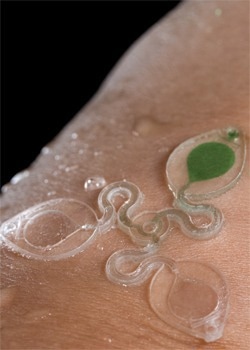
Image Credit: University of Hawai’i
Using the power of additive manufacturing (3D printing), scientists have come up with a new kind of wearable sweat sensor that extends the capability of wearable sweat devices.
The sweatainer is a compact wearable device similar in size to a small sticker that gathers and examines sweat, thereby providing a glimpse into the future of health monitoring. By integrating several sensors, the sweatainer could examine sweat in a fasion similar to earlier wearable sweat-sensing systems.
3D-printing enables an entirely new design mode for wearable sweat sensors by allowing us to create fluidic networks and features with unprecedented complexity.
Tyler Ray, Assistant Professor, Department of Mechanical Engineering, University of Hawaiʻi at Mānoa
Ray added, “With the sweatainer, we are utilizing 3D-printing to showcase the vast opportunities this approach enables for accessible, innovative, and cost-effective prototyping of advanced wearable sweat devices.”
Efficient and Cost-Effective Approach
Conventional methods for sweat collection utilize absorbent pads or microbore (very narrow) tubes that have been pressed against the epidermis (surface layer of the skin) using straps or bands to capture sweat as it arises from the skin.
Such methods need unique handling, trained personnel, and expensive laboratory equipment. The recent appearance of wearable sweat sensors has fulfilled a few of these difficulties, but these devices still remain for single use. When the device gets full, it should be removed, and the sweat collection be stopped.
One special feature of the sweatainer is its “multi-draw” sweat collection technique, which enables the collection of several separate sweat samples for analysis happening either directly on the device or sent to a laboratory.
Having been inspired by the vacutainer that has been utilized in clinical blood sampling, this progress not only makes sweat collection highly efficient but also sets the stage for new chances for at-home testing, storing samples for additional research, and combining with present health monitoring techniques.
Field studies of the sweatainer system emphasize the real-world potential of this innovative technology. Via the blueprint established in the sweatainer, the scientists hope that this will continue to drive novelty to make a future where personal health monitoring is highly accessible, comfortable, and perceptive.
Journal Reference
Wu, C-H., et al. (2023) Skin-interfaced microfluidic systems with spatially engineered 3D fluidics for sweat capture and analysis. Science Advances. doi.org/10.1126/sciadv.adg4272.